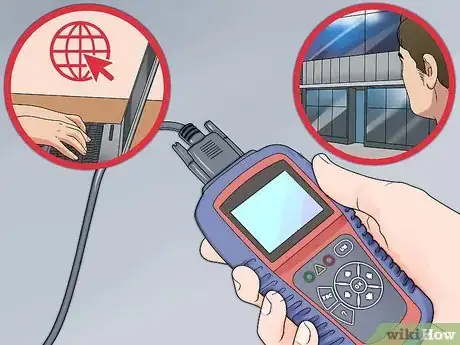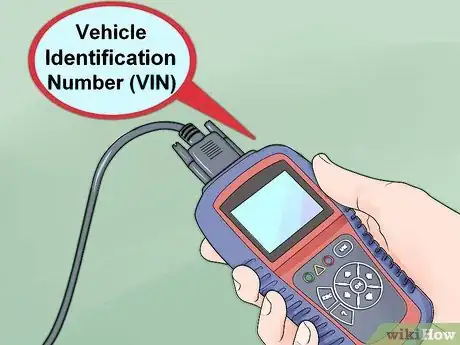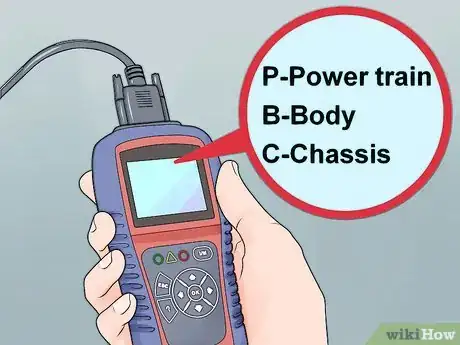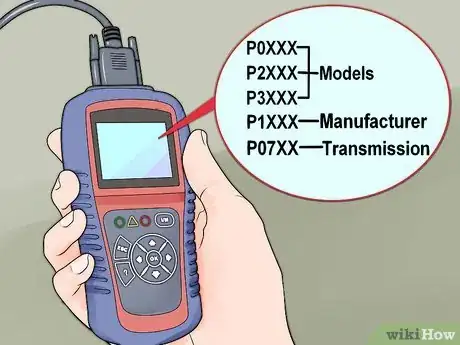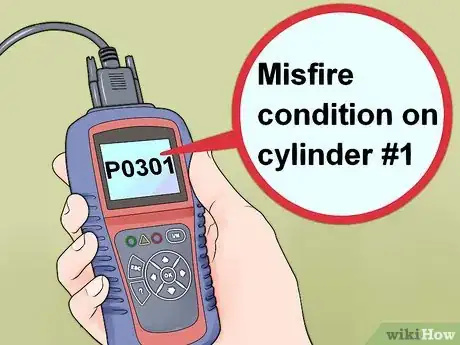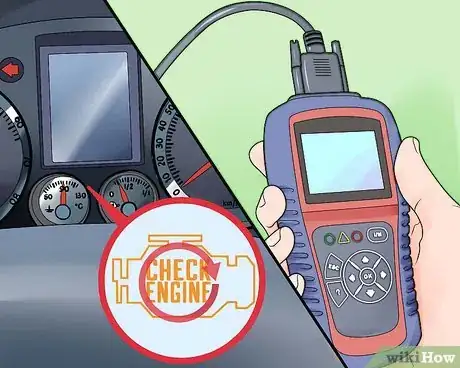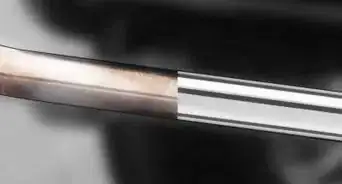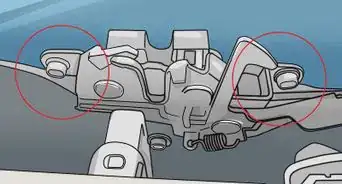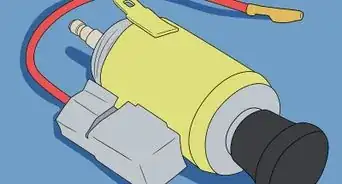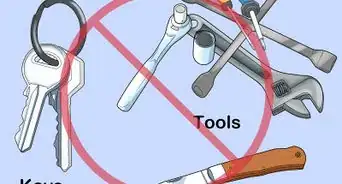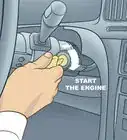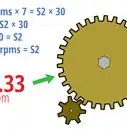This article was co-authored by Audra Fordin. Audra Fordin is a Certified Automotive Technician, the Founder of Women Auto Know, and the Owner of Great Bear Auto Repair in Flushing, New York. With more than 38 years of experience, she has intensive knowledge about foreign and domestic auto repairs. Audra has been featured on numerous news and talk shows such as The Today Show, Inside Edition, and Anderson Cooper.
wikiHow marks an article as reader-approved once it receives enough positive feedback. In this case, several readers have written to tell us that this article was helpful to them, earning it our reader-approved status.
This article has been viewed 333,558 times.
You’re cruising down the road, enjoying your drive, when all of a sudden that most mysterious of indicators turns on: “Check Engine”. What does it mean? The engine is a pretty vast and intricate machine, so “checking the engine” isn’t going to produce many answers. That’s where the OBD-II code reader comes in. This little device will allow you to pinpoint where that error is coming from.
Steps
Getting the Codes
-
1Obtain an OBD-II scan tool. You can find OBD-II scan readers at many online and auto-parts stores.[1] If you have a Bluetooth-enabled smartphone, you can download an app to interpret the data and purchase an OBD reader that will display the codes and explanations directly on your device.
- If your car/light truck is older than 1996 you will need to purchase an OBD-I scanner which are more vehicle specific and do not use the universal OBD-II coding system.[2] This article concentrates on the OBD-II system.
- OBD-II constantly monitors the performance of your engine and Emissions Control System. It will turn on your Check Engine Light whenever a malfunction occurs that causes the vehicle produced emissions to be greater than or equal to 150% of the Federal EPA mandated limits.
-
2Locate the Diagnostic Link Connector (DLC) in your vehicle. This is a somewhat triangular shaped 16-pin connector that is commonly located underneath the left hand side of the dash near the steering column. If you have trouble locating the DLC, search for the location on the internet using your car’s model and year, or refer to the owner’s manual.Advertisement
-
3Insert the scan tool connector or code reader into the DLC. Turn your ignition on, but do not start your engine. You will see the scanner begin to communicate with the onboard computers in your vehicle.[3] Messages like "searching for protocol" and "establishing data transmission link" may appear on the scanner's screen.
- If the screen stays blank and does not light up, jiggle the connector to achieve a better contact between the scanner and DLC connector pins. Older cars in particular may have poorer connections.
- If you still aren't having any luck, be sure that your cigar lighter works. This is because the OBD-II system uses the cigar lighter circuit to provide voltage to the DLC. If the cigar lighter does not work, locate and check the appropriate fuse.
-
4Enter in your vehicle information. On some scanners, you will need to input your VIN as well as the make and model of the vehicle. You may also need to specify the engine type. This process will vary depending on the scanner.
- You can usually find your VIN number on the bottom-left hand side of the windshield.
- VIN numbers are typically stamped on every single part of newer cars.[4]
-
5Find the menu. When the scanner finishes booting up, look for a menu. Select “Codes” or “Trouble Codes” to open the main Codes menu. Depending on your scanner and year of the vehicle you may be presented with a few systems such as Engine/Powertrain, Transmission, Airbag, Brakes etc. When you pick one, you will see two or more types of codes. The most common are Active codes and Pending codes.
- Active codes are live codes or malfunctions that are keeping your Check Engine Light on. Just because your Check Engine Light is off doesn't mean the code or malfunction disappeared, it just means that the code setting conditions haven't occurred for two or more operations of the vehicle.
- Pending codes mean that the OBD-II monitoring system has failed the operation of an emission control system at least once and if it fails again the Check Engine Light will be turned on and the malfunction becomes an Active code.
Understanding the Codes
-
1Learn what the letter means. Each code will start with a letter which designates what system the code is referring to. There are several letters that you may see, though you may have to move to different menus to see them:
- P - Powertrain. This covers the engine, transmission, fuel system, ignition, emissions, and more. This is the largest set of codes.
- B - Body. This covers airbags, seat belts, power seating, and more.
- C - Chassis. These codes cover ABS, brake fluid, axles, and more.
- U - Undefined. These codes cover other aspects of the car.
-
2Learn what the numbers mean. P0xxx, P2xxx, and P3xxx are all generic codes that apply to all makes and models. P1xxx codes are manufacturer specific, such as Honda, Ford, Toyota, etc. The second number tells you what subsystem the code refers to. For example, P07xx codes refer to the transmission.
- The last two digits are the specific problem that the code refers to. Check a code chart online for details on each specific code.
-
3Read an example code. P0301 indicates a misfire condition on cylinder #1. The P indicates it's a powertrain code, the 0 indicates that it is a generic or universal code. The 3 means the area or subsystem is an Ignition System code.[5]
- The 01 indicates it's a cylinder specific problem, in that there is a misfire condition in the number 1 cylinder. It could mean that the spark plug, plug wire or dedicated ignition coil are worn out or that there is a vacuum leak near the cylinder.
- A code does not tell you what component is defective; it only points to or indicates that a component, its circuit, or its wiring/vacuum control are malfunctioning. The code may be the symptom of a malfunction caused by a completely different system.
-
4Diagnose your vehicle. The proper diagnosis of OBD-II codes takes years of training and practice. For example, a weak battery or worn out alternator can set five or more codes in systems that are perfectly normal. Before attempting repairs, understand that the codes alone will not tell you what parts need to be replaced or what repairs need to be made.
- If you are unsure of what you are doing, take your car to an ASE Certified Master Technician with the L1 Advanced Engine Performance Diagnostic certification, or you could end up wasting a lot of time and money.
-
5Reset your Check Engine Light. If you’ve made your repairs, or simply don’t want to see your Check Engine Light for a while, you can reset it using most OBD scanners. The light will turn off until the car has been driven a certain amount of time (this varies from manufacturer to manufacturer).[6]
- You can reset the Check Engine Light from the main menu of most scanners. It is also referred to as a CEL.
Expert Q&A
-
QuestionHow do I decode OBD codes?
 Ed BeeryEd Beery is an Automotive Specialist and the Owner of InTechgrity Automotive Excellence based in Denver, Colorado. With more than eight years of experience, he specializes in providing maintenance and repair services for both individuals and companies. Ed and the InTechgrity Automotive Excellence Team are approved by the American Automobile Association (AAA) for repairs and are Automotive Service Excellence (ASE) certified.
Ed BeeryEd Beery is an Automotive Specialist and the Owner of InTechgrity Automotive Excellence based in Denver, Colorado. With more than eight years of experience, he specializes in providing maintenance and repair services for both individuals and companies. Ed and the InTechgrity Automotive Excellence Team are approved by the American Automobile Association (AAA) for repairs and are Automotive Service Excellence (ASE) certified.
Automotive Specialist Search the code on the internet. This can help you figure out the meaning of the code, along with possible causes and solutions.
Search the code on the internet. This can help you figure out the meaning of the code, along with possible causes and solutions. -
QuestionHow do I find my OBD port?
 Ed BeeryEd Beery is an Automotive Specialist and the Owner of InTechgrity Automotive Excellence based in Denver, Colorado. With more than eight years of experience, he specializes in providing maintenance and repair services for both individuals and companies. Ed and the InTechgrity Automotive Excellence Team are approved by the American Automobile Association (AAA) for repairs and are Automotive Service Excellence (ASE) certified.
Ed BeeryEd Beery is an Automotive Specialist and the Owner of InTechgrity Automotive Excellence based in Denver, Colorado. With more than eight years of experience, he specializes in providing maintenance and repair services for both individuals and companies. Ed and the InTechgrity Automotive Excellence Team are approved by the American Automobile Association (AAA) for repairs and are Automotive Service Excellence (ASE) certified.
Automotive Specialist Check under the dash on the driver's side! This is where most OBDII ports are located.
Check under the dash on the driver's side! This is where most OBDII ports are located. -
QuestionWhat is OBD device for car?
 Ed BeeryEd Beery is an Automotive Specialist and the Owner of InTechgrity Automotive Excellence based in Denver, Colorado. With more than eight years of experience, he specializes in providing maintenance and repair services for both individuals and companies. Ed and the InTechgrity Automotive Excellence Team are approved by the American Automobile Association (AAA) for repairs and are Automotive Service Excellence (ASE) certified.
Ed BeeryEd Beery is an Automotive Specialist and the Owner of InTechgrity Automotive Excellence based in Denver, Colorado. With more than eight years of experience, he specializes in providing maintenance and repair services for both individuals and companies. Ed and the InTechgrity Automotive Excellence Team are approved by the American Automobile Association (AAA) for repairs and are Automotive Service Excellence (ASE) certified.
Automotive Specialist An OBD device is better known as OBDII scan tool, which helps pull codes using the OBDII port on a vehicle.
An OBD device is better known as OBDII scan tool, which helps pull codes using the OBDII port on a vehicle.
Warnings
- Do not think that the code tells you which part to replace. The friendly but usually untrained auto parts clerk will be happy to suggest many parts to try, but this can get very expensive and even confuse the issue.⧼thumbs_response⧽
- After repairs are performed, a proper drive cycle must be performed to clear all the readiness monitors. So, if needed, an emission test can be performed and passed.⧼thumbs_response⧽
References
- ↑ Ed Beery. Automotive Specialist. Expert Interview. 19 November 2021.
- ↑ Ed Beery. Automotive Specialist. Expert Interview. 19 November 2021.
- ↑ Ed Beery. Automotive Specialist. Expert Interview. 19 November 2021.
- ↑ Audra Fordin. Certified Automotive Technician. Expert Interview. 13 January 2022.
- ↑ http://www.obd-codes.com/trouble_codes/
- ↑ http://www.popularmechanics.com/cars/how-to/maintenance/4267896
About This Article
To read OBD codes for cars made after 1996, you’ll first need to purchase an OBD-II scanner and connect it to your car’s Diagnostic Link Connector, which you can find by consulting either the internet or your owner’s manual. Turn on the ignition without starting the engine to start the link, and navigate to the scanner’s code menu. If you see any “active” or “pending” codes, refer to a code chart to learn more about exactly what and where the malfunction is. Scroll down for an in-depth explanation of the letter and number codes you might see and what they mean!
